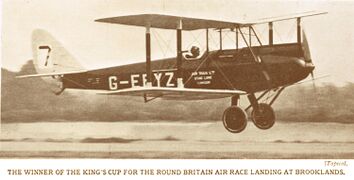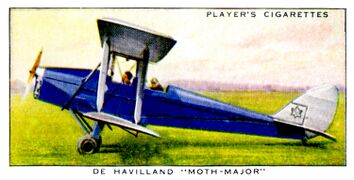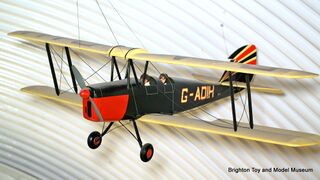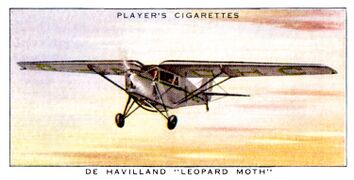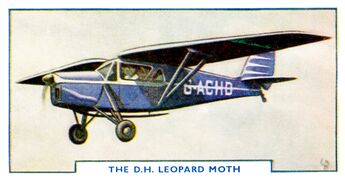Category:Moths (de Havilland)
1934: The "Moth" as a golfing accessory [image info]
1934: The "Moth" as a golfing accessory [image info]
The de Havilland Moths were a rare example of excellent marketing in the British aviation industry. Designed by Geoffrey de Havilland as light civilian, sports and trainer aircraft, the series started with the DH.60 Moth biplane, whose differently-engined variants then tended to be called after the name of the engine, with the version carrying a DH "Gypsy" engine becoming a "Gypsy Moth".
The moth branding was a stroke of genius, in that this was a type of flying creature that, while an insect, was furry and unthreatening and and made a funny noise. There were also a wide range of moth species with very cool prefix names, such as tiger moth, or leopard moth. This let DH call a model a "tiger" (moth) without it being confused with another company's "tiger" aircraft, and the distinctiveness of the moth theme meant that de Havilland effectively "owned" the theme: other companies couldn't copy it without infringing DH's trademark.
The "moths" were the dominant brand of light aircraft in the UK through the 1920s and 1930s, with DH making clever use of marketing photographs showing a moth with "MOTH" painted on the side in big letters to make it impossible for anyone looking at the image to mistake what they were seeing.
Quantity
DH eventually produced over nine thousand Moths, ninety percent of which were Tiger Moths (almost nine thousand "Tigers" and around nine hundred of the others).
Main aircraft models
1925: DH.60 Moth / Gypsy Moth
The original moth.
1927: DH.61 Giant Moth
Biplane, taking 8 passengers. The "Giant Moth" was an anomaly, as the Moth branding later became specific to non-commercial aircraft only.
- X
- X
- X
1928: DH.75 Hawk Moth
- X
- X
- X
1929: DH.80A Puss Moth
- X
1931: DH.82 Tiger Moth
- X
- X
1932: DH.83 Fox Moth
1933: DH.85 Leopard Moth
1934: DH.87 Hornet Moth
1937: DH.94 Moth Minor
Branding Dragons
While the popular DH.84 Dragon aircraft (used extensively as a mailplane and small passenger plane within the UK) was originally branded as a Dragon Moth, it was decided to drop the Moth suffix and reserve it only for noncommercial aircraft ... the Dragon was addressing a different market sector and was popular enough, with sufficient brand recognition, and a sufficiently cool name to be another very successful DH sub-brand in its own right.
August 1925 review:
The De Havilland "Moth"
THE De Havilland Type 60 two-seater light aeroplane, popularly known as the "Moth", is of particular interest for more than one reason. In the first place, the machine is unique in the fact that the planes are arranged to fold back along The fuselage to facilitate housing and transport. Not only does the folding of the wings allow the aeroplane to be stored in an ordinary garage, but it also allows the machine to be easily towed behind a motor-car along a road of ordinary width on which there is other traffic. Thus, supposing there be an aviation ground in a certain district, anyone living within easy access could own and fly a De Havilland "Moth" and store the machine at home, taking it by road to and from the aerodrome without any trouble.
London to Zurich and Back in a Day
The open span of 29 feet, required by the aeroplane in flight, is reduced to 9 feet 8 inches, with the wings folded back. The operation of folding the wings, or the alternative of spreading them, is not a long job requiring a number of mechanics, as might perhaps be supposed. It is claimed that it can be performed by one person in less than three minutes.
It was on an aeroplane of this type that Mr. Allan Cobham recently made his remarkable flight from Croydon to Zurich and back – a distance of about 1,000 miles – in one day. If any proof were needed that the "Moth" is capable of sustained flight this feat surely affords it, for the outward flight occupied six hours and the homeward journey eight hours.
In order to make the journey without landing, an extra petrol tank was carried instead of a passenger, and for the whole flight the consumption of fuel worked out at 20 miles to the gallon. This is, of course, even better than is achieved by motor cars of the same horse-power.
The flight was undertaken purely and simply as a demonstration of the "Moth-Cirrus" combination, and upon his return Mr. Cobham reported that he did not suffer one moment's anxiety as to the ultimate success of the flight. The engine ran without a falter for the whole fourteen hours and the ease of control of the machine, combined with the comfort of the cockpit, made the journey a very pleasant one. It is interesting to note also that this was the first occasion on which Mr. Cobham had flown for fourteen hours in one day.
"M.M." Readers May Fly a "Moth"
The "Moth" was produced in the first place for use of private owners and Light Aeroplane Clubs, and it has been adopted as the standard equipment of the clubs recently formed in London, Manchester, Leeds, Birmingham, and Newcastle.
These Light Aeroplane Clubs are being formed in different parts of the country with the support of the Air Ministry, and at the meeting of the Royal Aero Club this month one race is being specially organised for their members. No doubt, in a few years time these clubs will be very popular and as aeroplanes of the "Moth" will be largely used it is possible that quite a number of the readers who are perusing this page ma in a few years' time be flying "Moths" through the medium of one or other of the new flying clubs.
In this connection it is interesting to learn that it has it ha recently been stated that on an average about five hours instruction only is required to learn to fly, and this instruction can be obtained through these clubs at a cost of about £10 or £12.
A Low Compression Engine Desirable
The "Moth" is by no means a frail craft demanding highly skilled attention, but has been designed on simple and robust lines to give reliability of running, ease of handling, and economical maintenance. It is fitted with one of the new 27/60 lip. four-cylinder Cirrus engines, noted for their smooth and vibrationless running.
The petrol tank is divided into main and reserve compartments, the former having sufficient spirit for a three hours' flight, and the latter for half-an-hour. It is stated that when carrying auxiliary petrol tanks in place of a passvngcr, a flight can be made from London to Glasgow and back without stopping, and that the machine can remain in the air for over twelve hours without landing.
Owing to the limitation of 1,100 cc. at the last Lympne trials, engine-makers were forced to develop a high-compression engine with a high piston-speed, whereas the ideal engine for club and private work is rather on the low side as regards compression and piston speed. An engine of this type gives reliability over long periods without overhauls.
The "Moth" scores heavily because the power unit is of generous proportions, developing over 60 h.p. This has enabled the aeroplane to be planned on more ample lines and enables 50% of the h.p. in reserve to be obtained in level flight at about 70 to 75 miles an hour, an important feature that cannot be overestimated. in the early days of the new flying clubs it will be far better to employ an engine which, although not so economical on petrol consumption, has the more important consideration of reduced risk of engine failure and the compensating advantage of much less time and money spent on maintenance.
The Hand Starter for Engine
As already mentioned, the "Moth" is a two-seater, the pilot's and passenger's cockpits being placed in tandem. There is also accommodation in each for light luggage. Flying is particularly easy with light and effective control down to the lowest speeds and no peculiarities of behaviour.
The undercarriage, which employs rubber in compression, will absorb the shocks of landing on the roughest ground. With full load — that is, pilot, passenger and 60 lbs. of luggage — the stalling speed is 40 miles an hour. Its top speed is over 90 miles per hour.
A noticeable feature of the engine is the hand starter, which is operated by the pilot from his seat. Generally, the starting of an aeroplane engine requires the assistance of at least two men besides the pilot. The engine of the "Moth" can be started-up without any exertion or difficulty, however, and the pilot can handle and manouvre the machine on the ground without assistance " I recently saw for the first time", a correspondent writes, "a simple hand-starter provided for starting an aeroplane. When I went up in a Moth with Mr. Hubert Broad, he merely pulled a lever twice and the engine began to tick over gently. Even when cold a few preliminary turns of the propeller, to suck in gas were sufficient to prepare the way for the hand-starter".
A Trial Flight Described
Further describing his experience our correspondent writes:– " The passenger's cockpit over the centre of gravity, is by far the most comfortable I have experienced. Even with a heavy coat there is no difficulty in accommodating oneself, and the cowling and windscreen make the use of goggles quite unnecessary.
"When I made my trial night, the getting-off conditions were bad, owing to the aerodrome being waterlogged. We only got off after a much longer run than usual, but once off the machine had a very good rate of climb."
"It was doing 60 miles air speed with the engine revolution counter at between 1,550 and 1,600. At 1,650 the speed rose to about 65 m.p.h. and then we cruised round with the airspeed anything from 70 to 75 mph with 1,630 to 1,700 revolutions indicated — just 300 short of the usual maximum and 400 below the absolute maximum. We landed at just under 50 miles an hour, but under better conditions its low SFCCJ is stated to be 38 miles an hour, while the top speed is 90.
"The weather was somewhat bumpy, but the machine was surprisingly steady, and Mr. Broad stated that it was exceedingly comfortable to fly. On his previous flight alone he had shown its powers by looping, spinning, and carrying out Immelman turns at about 1,000 feet up with perfect ease.
The Strongly-Designed Engine
The engine that makes all this possible is the 60 h.p. Cirrus, an air-cooled four-cylinder in-line type. The engine is rated to give 65 h.p. at 2,000 revolutions, and may be run at 2,100 in short bursts. Its normal 60 h.p. is delivered at 1800, and at 1,700 giving the cruising speed already referred to, it is only being asked to deliver 33 h.p. It is then consuming a gallon of petrol per 25 miles flown, and its oil-consumption is a pint an hour.
It is clear that the engine is normally not being taxed at all hardly – it is certainly a very comfortable engine to sit behind – and apart from that, as it is in part based upon the 120 h.p. Airdisco air-cooled engine, which in turn is based on the old Renault engine, some of the working parts have a very large margin of structural strength. The crankshaft, bearings. and connecting rods, for instance, are taken from the 120 h.p. engine and have passed the Air Ministry type tests in the larger engine and have stood the strain of working at 145 h.p. for an hour on the test bench.
Interesting Details of the "Moth"
Admittedly the engine is on the heavy side at 260 lb. for its 65 h.p., but this is really of small account if it can be relied upon to run with the minimum of attention day after day under the conditions of club and amateur work. It is hoped it will run 200 hours or more between overhauls, and this translates into mileage means 15,000 miles at a conservative estimate.
— , -, , Meccano Magazine, , August 1925
Pages in category ‘Moths (de Havilland)’
The following 4 pages are in this category, out of 4 total.
Media in category ‘Moths (de Havilland)’
The following 18 files are in this category, out of 18 total.
- Aeroplane Builder, Xacto, Hamleys (MM 1931-04).jpg 2,400 × 1,949; 604 KB
- De Havilland Leopard Moth, Card No 13 (JPAeroplanes 1935).jpg 3,000 × 1,529; 544 KB
- De Havilland Moth-Major, Card No 12 (JPAeroplanes 1935).jpg 3,000 × 1,529; 579 KB
- DeHavilland Tiger Moth, radio controlled model biplane (Denis Hefford).jpg 2,000 × 1,125; 1.06 MB
- DH Leopard Moth aeroplane, Dinky Toys 60b (1935 BoHTMP).jpg 397 × 237; 15 KB
- DH Leopard Moth, Card No 30 (GPAviation 1938).jpg 2,400 × 1,254; 441 KB
- DH Moth Seaplane (WBoA 8ed 1934).jpg 2,030 × 3,000; 1.64 MB
- DH Moth, on the golf course 01 (WBoA 8ed 1934).jpg 3,000 × 2,336; 1.32 MB
- DH Moth, on the golf course 02 (WBoA 8ed 1934).jpg 3,000 × 2,076; 1.2 MB
- DH-60G Gypsy Moth G-EBYZ, Brooklands (WBoA 6ed 1928).jpg 3,000 × 1,526; 755 KB
- DH-60G Gypsy Moth in flight (WBoA 6ed 1928).jpg 3,000 × 1,951; 1.13 MB
- Dive-Bomber Fighter, camouflaged, Dinky Toys 66b (MM 1940-07).jpg 1,328 × 820; 87 KB
- Gypsy Moth (WBoA 8ed 1934).jpg 3,000 × 2,248; 1.35 MB
- Lady Bailey, DH Moth, Croydon (WBoA 6ed 1928).jpg 3,000 × 2,020; 1.02 MB
- Puss Moth Cabin Monoplane model, FROG (MM 1935-08).jpg 1,540 × 1,637; 270 KB
- Puss Moth, DH-80a G-AAXY flying model aircraft, 3160 (TriangCat 1937).jpg 1,339 × 1,600; 301 KB
- Xactus model Aircraft Construction Sets, DH Moth (MM 1931-03).jpg 2,271 × 3,000; 988 KB
- Youth of Ireland DH-83 Fox Moth (WBoA 8ed 1934).jpg 3,000 × 2,215; 1.46 MB


